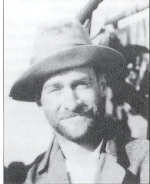 - "That famous author's brother" (Bagnold's sister, Enid, is the author of National Velvet) had served in the trenches of France in the first World War and was stationed in Egypt during most of the inter-war years where he became an avid desert explorer, organizing several long expeditions through the Sinai, the Trans-Jordan Desert and the Sahara and laying much of the groudwork that would later benefit his patrols.
- "That famous author's brother" (Bagnold's sister, Enid, is the author of National Velvet) had served in the trenches of France in the first World War and was stationed in Egypt during most of the inter-war years where he became an avid desert explorer, organizing several long expeditions through the Sinai, the Trans-Jordan Desert and the Sahara and laying much of the groudwork that would later benefit his patrols.When the war broke out, Bagnold was commanded to Kenya, but a fortunate accident of his ship near Port Said delayed his passage and led to a meeting with General Wavell, who had an open ear for Bagnold's ideas of piracy on the desert. Subsequently, Bagnold called together his old explorer buddies and proceeded to form LRP (which was soon renamed LRDG). Even though Bagnold soon stepped down from commanding the unit and concentrated on staff work in Cairo, it was his expertise in formulating requirements for the Group's tactics and equipment that enabled LRDG to become one of the most successful special forces units of the war.
Bagnold retired from the Army and returned to England after the war, but the desert bug had not left him: he went on to become an authority on the physics of sand dune formation and movement.
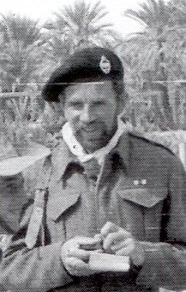
 - After entering the Italian Army in 1903, Graziani served in Africa almost continually since 1908 (with the notable exception of the first World War, during which he was stationed at the Northern Italian border). Back in Africa, Grazinai organized Italian strikes in Libya and Ethiopia (where his cruel actions against civilians earned him the unpleasant nickname "butcher") and quickly rose through the military hierarchy (1930 Lieutenant General, 1932 General, 1935 Gouvernor of parts of Libya and Somalia, 1936 Marshal and Vice-King of Ethiopia). In November 1940, after the sudden death of Marshal Balbo, Graziani became supreme commander of all Italian troops in Africa; subsequently, Graziani commanded the Italian incursion into Egypt that was stopped in no small part thanks to LRDG's early actions behind Italian frontlines. After the initially successful Italian offensive ground to a halt, Graziani lost the favor of his superiors and was forced to step back from his command in March 1941. In 1945, Graziani was arrested in Northern Italy and charged with treason for collaborating with German troops after the Italian armistice was signed. Though found guilty and sentenced to 19 Years in prison, Graziani was released for custody and later became active with the neofascist party.
- After entering the Italian Army in 1903, Graziani served in Africa almost continually since 1908 (with the notable exception of the first World War, during which he was stationed at the Northern Italian border). Back in Africa, Grazinai organized Italian strikes in Libya and Ethiopia (where his cruel actions against civilians earned him the unpleasant nickname "butcher") and quickly rose through the military hierarchy (1930 Lieutenant General, 1932 General, 1935 Gouvernor of parts of Libya and Somalia, 1936 Marshal and Vice-King of Ethiopia). In November 1940, after the sudden death of Marshal Balbo, Graziani became supreme commander of all Italian troops in Africa; subsequently, Graziani commanded the Italian incursion into Egypt that was stopped in no small part thanks to LRDG's early actions behind Italian frontlines. After the initially successful Italian offensive ground to a halt, Graziani lost the favor of his superiors and was forced to step back from his command in March 1941. In 1945, Graziani was arrested in Northern Italy and charged with treason for collaborating with German troops after the Italian armistice was signed. Though found guilty and sentenced to 19 Years in prison, Graziani was released for custody and later became active with the neofascist party.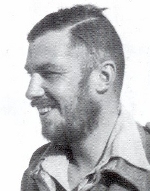
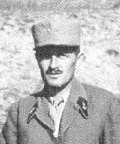 - Philippe-Marie, Vicomte de Hautecloque served as an infantry commander during the German invasion of France; after being captured, he managed to escape to England where he joined de Gaulle's Free French Army and changed his name to Leclerc to spare his family in France from reprisals. He was sent to French Equatorial Africa and subsequently led his force up through Chad to Southern Libya, where he often cooperated with LRDG patrols attacking Italian forts in the area. After joining up with the British 8th Army near Triplois, Leclerc partook in the Normandy invasion as commander of a French armoured division. On August 26th, 1944, Leclerc and de Gaulle triumphantly entered Paris after the city's German garrison had surrendered. After the war, Leclerc was sent to French Indochina, but his views of the situation there were unpopular with his superiors, resulting in his being reposted to North Africa where he died in a plane crash in 1947.
- Philippe-Marie, Vicomte de Hautecloque served as an infantry commander during the German invasion of France; after being captured, he managed to escape to England where he joined de Gaulle's Free French Army and changed his name to Leclerc to spare his family in France from reprisals. He was sent to French Equatorial Africa and subsequently led his force up through Chad to Southern Libya, where he often cooperated with LRDG patrols attacking Italian forts in the area. After joining up with the British 8th Army near Triplois, Leclerc partook in the Normandy invasion as commander of a French armoured division. On August 26th, 1944, Leclerc and de Gaulle triumphantly entered Paris after the city's German garrison had surrendered. After the war, Leclerc was sent to French Indochina, but his views of the situation there were unpopular with his superiors, resulting in his being reposted to North Africa where he died in a plane crash in 1947.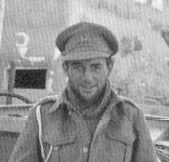
 After being educated at Sandhurst, Montgomery joined the British Army in 1908. From 1939 to 1940 (until the evacuation at Dunkirk), he commanded the 3rd Division in France; in 1942, he was sent to Egypt to replace General Auchinleck. After having stopped the German advance at Alamein, he drove back the Germans through Libya and Tunisia and consequently partook in the invasions of Sicily and Italy. Montgomery also helped formulate the invasion plan for Normandy and was field commander of all ground forces during the following campaign. His plan to advance into Germany via the Rhine bridge at Arnhem led to one of the worst disasters Allied troops had to suffer during the war.
After being educated at Sandhurst, Montgomery joined the British Army in 1908. From 1939 to 1940 (until the evacuation at Dunkirk), he commanded the 3rd Division in France; in 1942, he was sent to Egypt to replace General Auchinleck. After having stopped the German advance at Alamein, he drove back the Germans through Libya and Tunisia and consequently partook in the invasions of Sicily and Italy. Montgomery also helped formulate the invasion plan for Normandy and was field commander of all ground forces during the following campaign. His plan to advance into Germany via the Rhine bridge at Arnhem led to one of the worst disasters Allied troops had to suffer during the war.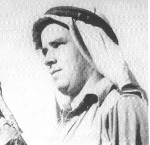
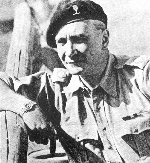 Vladimir Peniakoff was born in Belgium as son of Russian immigrants, but moved to Egypt in the 1920s where he became a successful businessman and spent his ample free time exploring the Western Desert. When war broke out, he tried to join the British Army as a volunteer but was initially rejected since he was a Belgian citizen and his country was still neutral. After the German invasion of Belgium, he was finally accepted and offered a post as a staff officer - but he had set his mind to working in the desert. After struggling with the Army authorities for a while, he was finally allowed to join LRDG late in 1941 and form a more or less independent subsection called "No.1 Demolition Squadron", which was intended to assist LRDG on sabotage missions. Since this concept did not work out too well (LRDG's success was mainly attributed to stealth, and it was thought that blowing things up in a grand manner might give the enemy too many clues about the whereabouts of Patrols), Popski was authorized to form an independent strike force in March 1942, using Jeeps armed with Browning .30cal and .50cal machine guns. The unit's name, "Popski's Private Army", started out as a joke ("Popski", by the way, was the nickname given to Peniakoff by LRDG's radio operators who obviously had some trouble spelling and pronouncing his name), but since nobody could come up with a better name, it stuck. The unit subsequently operated in the Fezzan area, where Popski's main duty was to keep the Senussi tribes in line and keep them from foolishly starting a revolt (which would no doubt have caused a bloody Italian reprisal and would have filled LRDG's operational area with lots of Italian troops). His unit later worked its way up through Tunisia and served as an intelligence-gathering and surveillance unit behind German lines in Italy.
Vladimir Peniakoff was born in Belgium as son of Russian immigrants, but moved to Egypt in the 1920s where he became a successful businessman and spent his ample free time exploring the Western Desert. When war broke out, he tried to join the British Army as a volunteer but was initially rejected since he was a Belgian citizen and his country was still neutral. After the German invasion of Belgium, he was finally accepted and offered a post as a staff officer - but he had set his mind to working in the desert. After struggling with the Army authorities for a while, he was finally allowed to join LRDG late in 1941 and form a more or less independent subsection called "No.1 Demolition Squadron", which was intended to assist LRDG on sabotage missions. Since this concept did not work out too well (LRDG's success was mainly attributed to stealth, and it was thought that blowing things up in a grand manner might give the enemy too many clues about the whereabouts of Patrols), Popski was authorized to form an independent strike force in March 1942, using Jeeps armed with Browning .30cal and .50cal machine guns. The unit's name, "Popski's Private Army", started out as a joke ("Popski", by the way, was the nickname given to Peniakoff by LRDG's radio operators who obviously had some trouble spelling and pronouncing his name), but since nobody could come up with a better name, it stuck. The unit subsequently operated in the Fezzan area, where Popski's main duty was to keep the Senussi tribes in line and keep them from foolishly starting a revolt (which would no doubt have caused a bloody Italian reprisal and would have filled LRDG's operational area with lots of Italian troops). His unit later worked its way up through Tunisia and served as an intelligence-gathering and surveillance unit behind German lines in Italy.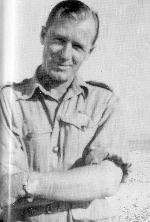
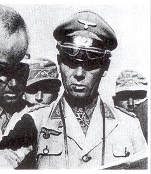 - Commander of the German Afrika Korps and one of the most prolific figures of World War 2. Rommel's career in the German Army (which he entered in 1910) was difficult from the outset - as a small-town boy from Southern Germany, he was not easily accepted by a General Staff that was dominated by Prussian Aristocracy. During the First World War, Rommel was stationed on the Italian front and was highly decorated - a fact that did not exactly make it easy for him to get along with the Italian commanders in Africa. Rising quickly through the army ranks under Hitler, Rommel was a General by 1940 and proved his proficiency as a tank commander during the invasion of France. His stunning successes (along with his image of being a "man of the people", as opposed to the other aristocratic army commanders) made him an ideal object for the Reich's propaganda, and he was continually celebrated as the greatest hero the German Army had in its ranks.
- Commander of the German Afrika Korps and one of the most prolific figures of World War 2. Rommel's career in the German Army (which he entered in 1910) was difficult from the outset - as a small-town boy from Southern Germany, he was not easily accepted by a General Staff that was dominated by Prussian Aristocracy. During the First World War, Rommel was stationed on the Italian front and was highly decorated - a fact that did not exactly make it easy for him to get along with the Italian commanders in Africa. Rising quickly through the army ranks under Hitler, Rommel was a General by 1940 and proved his proficiency as a tank commander during the invasion of France. His stunning successes (along with his image of being a "man of the people", as opposed to the other aristocratic army commanders) made him an ideal object for the Reich's propaganda, and he was continually celebrated as the greatest hero the German Army had in its ranks. - A noted archeologist and one of the band of desert explorers that spent their time with Bagnold in the pre-war years, Shaw discovered a number of rock paintings in the Libyan desert during their expeditions in the 1920s and 30s (among them the "cave of swimmers" that was featured in The English Patient). Quickly contacted by Bagnold when LRDG was formed, Shaw was one of the GRoup's founding members and became the Group's intelligence officer. He published his account of the war, entitled "Long Range Desert Group", in 1945, when much of the information was still classified and most of the names had to be changed.
- A noted archeologist and one of the band of desert explorers that spent their time with Bagnold in the pre-war years, Shaw discovered a number of rock paintings in the Libyan desert during their expeditions in the 1920s and 30s (among them the "cave of swimmers" that was featured in The English Patient). Quickly contacted by Bagnold when LRDG was formed, Shaw was one of the GRoup's founding members and became the Group's intelligence officer. He published his account of the war, entitled "Long Range Desert Group", in 1945, when much of the information was still classified and most of the names had to be changed. - Stirling, the son of a Brigadier General, joined the Army in 1939 and was transferred to the Guard's commando brigade in Cairo in 1940. He subsequently convinced his superiors to form a desert strike force that was to be called "SAS" and was initially intended to operate airborne. However, after the first SAS raid went horribly wrong and most of Stirling's paratroopers were either killed or captured, subsequent SAS raids were carried out in very similar fashion to LRDG's methods - using light trucks and Jeeps to cross the desert, then disappearing quickly into the endless sand dunes (until Stirling finally managed to get some Jeeps for his unit in 1942, the SAS had relied on LRDG transport to get them to their destinations and back to safety).
- Stirling, the son of a Brigadier General, joined the Army in 1939 and was transferred to the Guard's commando brigade in Cairo in 1940. He subsequently convinced his superiors to form a desert strike force that was to be called "SAS" and was initially intended to operate airborne. However, after the first SAS raid went horribly wrong and most of Stirling's paratroopers were either killed or captured, subsequent SAS raids were carried out in very similar fashion to LRDG's methods - using light trucks and Jeeps to cross the desert, then disappearing quickly into the endless sand dunes (until Stirling finally managed to get some Jeeps for his unit in 1942, the SAS had relied on LRDG transport to get them to their destinations and back to safety).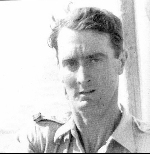
 Supreme Commander of the Brithish Middle Eastern Troops since 1937, General Wavell has the distinction of having won the first British victory of World War 2 when stopping Graziani's invasion late in 1940. His counterattack, however, failed when Rommel's Afrika Korps was moved into the theatre; Wavell was subsequently replaced by General Auchinleck and was removed to the Southeast Pacific (Wavell was Supreme Commander of that area until that post was abolished soon after when it became obvious that British control of the region was lost). Until his resignation in 1947, he remained governor of India and was working towards the preparation of Indian self-rule.
Supreme Commander of the Brithish Middle Eastern Troops since 1937, General Wavell has the distinction of having won the first British victory of World War 2 when stopping Graziani's invasion late in 1940. His counterattack, however, failed when Rommel's Afrika Korps was moved into the theatre; Wavell was subsequently replaced by General Auchinleck and was removed to the Southeast Pacific (Wavell was Supreme Commander of that area until that post was abolished soon after when it became obvious that British control of the region was lost). Until his resignation in 1947, he remained governor of India and was working towards the preparation of Indian self-rule.